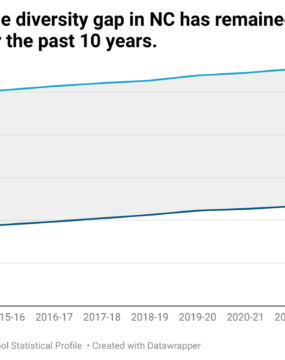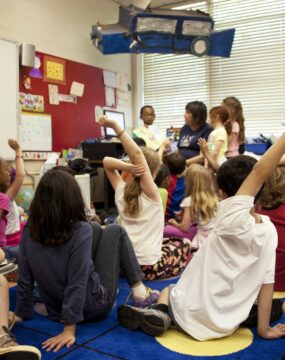Posts written by Joanne Brosh
Keep up with our latest demographic insights

Teacher diversity has been found to be linked to improved educational outcomes for all students, with more targeted gains for students of color. Specifically, having a same-race teacher is associated with improved test scores, grades, and attendance, as well as a higher probability of taking advanced math courses, being selected for gifted and talented programs, graduating high school, and enrolling in college. Despite demographic shifts with the state population overall, data suggest there’s still a…

Results from the National Assessment of Student Progress (NAEP), known also as the Nation’s Report Card, have been getting a lot of attention over the past month. The US Secretary of Education has called the results “unacceptable.” North Carolina’s Superintendent, Catherine Truitt, said the results were unsurprising, given the COVID-19 impact on K-12 learning in the state. What did the results show? National 2022 test scores showed an average decline of 5 points in reading…


The population of homeless students enrolled in public school districts nationwide decreased 4% between the 2017-18 and 2018-19 school years, according to The National Center for Homeless Education (NCHE) at UNC-Greensboro, which recently released their annual look at children experiencing homelessness and attending public school. Nationally, there were 1,384,301 homeless youth enrolled in public school in the 2018-19 school year. However, things looked very different in North Carolina. In 2017-18, there were an estimated 28,903…




The pandemic has increased the rate of homeschooling substantially, both nationally and at the state level. In North Carolina, the number of home schooled students increased by 21% from 2019-20 (149,173 students) to 2020-21 (179,900 students). In this blog post, we take a closer look at North Carolina’s data to see how the percentage increase of homeschooled students varies across counties. All 100 counties across North Carolina saw increase in homeschooled students Data provided from…


A growing number of Americans are teaching their children at home. According to the National Center for Education Statistics, the number of homeschooled students nearly doubled nationally from 850,000 in 1999 to 1,690,000 in 2016. The percentage of students who were homeschooled increased from 1.7 percent of all students to 3.3 percent of all students over the same time. The pandemic has dramatically increased the number of homeschooled students nationally. The U.S. Census Bureau created…


The labor force participation rate describes the percentage of people 16 or older who are working or actively looking for work. Nationally, the seasonally-adjusted labor force participation rate for the United States in June 2021 was 61.6%. In North Carolina, the participation rate was 59.2%, 2.4 percentage points below the national rate. Why does the labor force participation rate matter and what does it tell us? The labor force participation rate is a measure of how…
On March 24th, Governor Cooper directed $51.4 million in new funding to help students access and complete postsecondary education as the state recovers from the repercussions of the COVID-19 pandemic. The funding is drawn from North Carolina’s share of the Governor’s Emergency Education Relief (GEER) fund, which are federal funds appropriated to assist educational institutions, from school districts, postsecondary institutions, and other education opportunities to reduce the detrimental impact from COVID-19. North Carolina will invest:…


The National Student Clearinghouse Research Center (NSCRC) regularly publishes research supporting education, workforce, and learner success, by identifying different student educational pathways. Specifically, the NCSRC calculates the number of high school graduates who immediately enroll in college after graduation. In March 2021, the NSCRC released a report on on-time fall college data enrollment that addressed the impact of COVID-19. This report corrected an earlier December release that said that on-time fall postsecondary enrollment had declined…




It has been a little over a year since the pandemic shut down workplaces and schools across North Carolina. In this post, we detail what Carolina Demography has learned about the pandemic’s effect on the educational system in NC. First, let’s start with a short timeline: On March 15, 2020, NC Governor Roy Cooper signed an executive order to close all K-12 public schools for a minimum of two weeks. During the next three weeks,…


This blog is the second in a series exploring myFutureNC’s statewide dashboard indicators, which span the educational continuum. Read the complete series. This week, we’ll be going in depth on two similar indicators - College-and-Career-Ready in reading and math. Although we provide detailed information on NC, national data on the percent of 3-8 grade students who earned college-and-career-ready scores on End-of-Grade (EOG) reading and math exams are not available, and therefore we cannot compare North Carolina to other states. What…
Your support is critical to our mission of measuring, understanding, and predicting population change and its impact. Donate to Carolina Demography today.